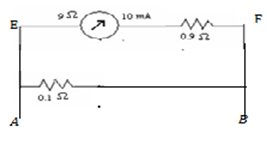Current Electricity - Online Test

Thee above circuit can be redrawn as:
Total resistance in the arm EF ( milliammeter and the 0.9Ω resistor)= 9+0.9=9.9Ω.
Since the milliammeter gives full scale deflection when A and B are used as its terminals, the current in the arm EF is 10 mA. The potential difference across the arm is
VEF = Ig* R = 10(10^ - 3) * 9.9 = 0.099V.
The potential difference across AB= potential diff across the 0.1Ω resistor= VEF = 0.099 V.
The current through the 0.1Ω resistor
The total current I is the sum of I0.1 and Ig
= Ig + I0.1 = 0.01 + 0.99 = 1A.
Mobility is defined as the drift velocity acquired by the charge per unit electric field strength. Faster the particle moves in a given electric field strength greater is the mobility.
If the battery has an e.m.f E, resitance of the potentiometer is R and the internal resistance of the battery is r, then the current I flowing in the potentiometer wire is given as
If the battery has an e.m.f E, the resitance of the potentiometer is R and internal resistance of the battery is r, then the current I flowing in the potentiometer wire is given as,
The potential difference V across the potentiometer is

If the battery has an e.m.f E, resitance of the potentiometer is R and the internal resistance of the battery is r, then the current I flowing in the potentiometer wire is given as,
The potential difference V across the potentiometer,
The potential gradient = ( potential drop across the potentiometer)/ length of the potentiometer wire)
= V/l
= 1.6/1
Potential gradient = 1.6 V/m
If the battery has e.m.f E, resitance of the potentiometer is R and the internal resistance of the battery is r, then the current I flowing in the potentiometer wire is given by,
The potential difference V across the potentiometer
The potential gradient = ( potential drop across the potentiometer)/ length of the potentiometer wire)
= V/l
= 1.6/1
Potential gradient = 1.6 V/m
The emf of the cell

The total resistance is the sum of the resistance of the potentiometer and the external resistance.
R = Rpot + Rext = 5 + 995 = 1000 ohms .
The current through the potentiometer wire I = E/R = 10/1000 = 0.01A.
The potential drop across the potentiometer wire is
The potential gradient = ( potential drop across the potentiometer wire)/ length of the potentiometer wire)
= 0.05/10
= 5 × 10-3 V/m
= 5 m V/m
The total resistance is the sum of the resistance of the potentiometer and the external resistance.
Current through the potentiometer is
The potential drop across the potentiometer
The potential gradient = ( potential drop across the potentiometer)/ length of the potentiometer wire)
